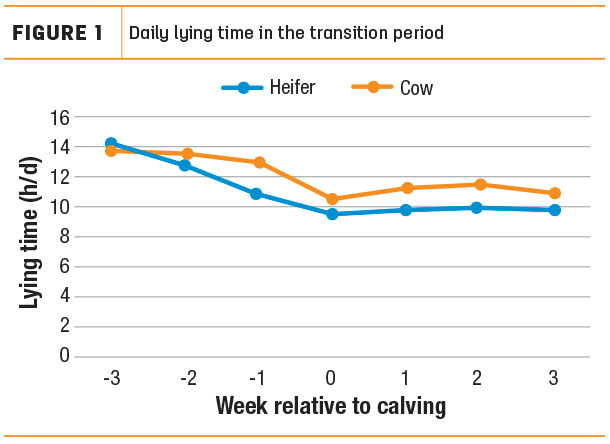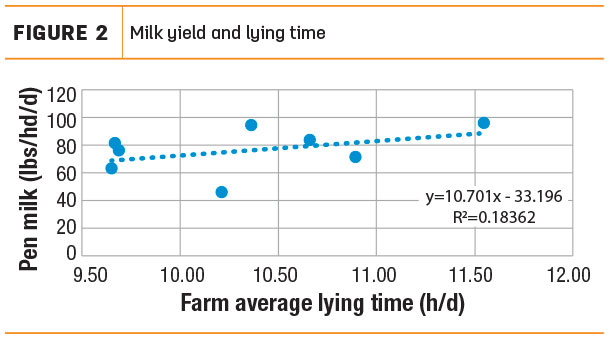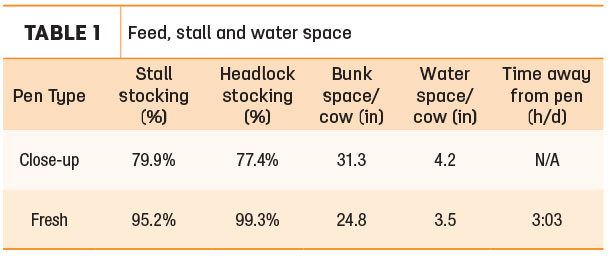The C.O.W.S. program has been successful in working with dairy producers and their teams to unlock bottlenecks in their operations.
The program is provided by Novus International and was developed in collaboration with Dan Weary and Marina Von Keyserlingk from the University of British Columbia. It started in 2010 with the assistance of two graduate students from the University of British Columbia visiting and collecting data from mature, high-production Holstein pens from 200 dairy farms in the U.S.
This allowed for the creation of three benchmarks across the U.S., including Northeast freestall, California freestall and Texas/New Mexico open lot.
In 2011, the program was commercially available to producers across the U.S. and Canada. To date, over 1,200 assessments have been completed, along with the creation of four additional freestall regions and plans to create an additional open lot region, and a Jersey breed benchmark to allow producers to compare their herds against their peers’ herds.
During a C.O.W.S. assessment, typically a mature, high-production pen is selected. The assessment starts off with a questionnaire where the producer, or herdsman, is asked management and facility questions. Following the questionnaire, 40 randomly assigned cows will receive accelerometers to measure the three-day average of daily lying behavior, and all cows in the pen are scored for hock and knee injuries.
This process is completed in the parlor during one milking. Next, pen-based facility measurements are taken. These include measurements on bunk and water space, stall stocking density and stall dimensions. Cows are evaluated for locomotion and time away from the pen.
After the data has been collected, a report is scheduled with the dairy producer, nutritionist, vet, other consultants and one of our sales managers to help uncover bottlenecks and facilitate a discussion towards unlocking those bottlenecks.
Some improvements we have found after reassessing the herd include reductions in lameness and injuries to hocks and knees while improving lying time.
After C.O.W.S assessments, some of the changes made by producers were moving the position of the neck rail, changing the timing of taking cows to the parlor and renovating stalls from mattress to deep bed. C.O.W.S. is available for reassessment if the producer would like to determine whether their changes improved metrics like lying time or reduced lameness prevalence.
How the transition C.O.W.S program differs
While we continue to offer the pen-based assessment service (C.O.W.S.), our team understands the need for a more thorough assessment for transition dairy cows. Approximately 50 percent of transition cows have some clinical or subclinical health event in early lactation, and over 55 percent of cows that die on farm occur within the first 100 days in milk.
This highlights the need for further research in this field. In April 2016, the first assessment of the current program was completed in the Upper Midwest. Today, 21 transition herds have been assessed across the U.S. and Canada. The transition assessment enrolls 40 focal cows approximately 260 to 270 days carrying calf to receive accelerometers that measure lying behavior for 22 days.
These cows are scored on body condition, hygiene, gait and for hock and knee injuries. When the accelerometers are removed 23 days later, cows are scored again for the outcome base measures and facility measures taken from the far-off, close-up and fresh pens.
Management questions regarding the timing of commingling and milking frequency, are addressed in a questionnaire. The focal cows are then followed up to approximately 150 days in milk to examine health events, milk yield and components along with reproductive efficiency. While this program is still in its early stages, we anticipate with this data we can help dairy producers and their teams unlock bottlenecks affecting transition cow success on their operations.
Preliminary outcome-based welfare measures with transition cows
Within the C.O.W.S. database, lameness in the mature, high-production pens across the U.S. averaged 26.4 percent, with the Jerseys having the lowest prevalence at 16.5 percent and the highest prevalence in the Northeast and Midwest at 31.4 percent and 32.1 percent, respectively.
Our preliminary data with the transition benchmark has overall lameness of 37 percent in the close-up pen and 41.6 percent in the fresh pen.
This data was somewhat surprising considering all dairies assessed trimmed all cows at dry-off, approximately one month prior to C.O.W.S. assessing the pen. Data from the University of Wisconsin cited 87.5 percent of mature cows and 23.5 percent of bred heifers showed evidence of abnormal gait while in the close-up period. The significant levels of lameness during this period highlight the need for further research to identify the causes of increased lameness prevalence. Providing cows a comfortable lying base, large enough stalls and proper footbath usage can help reduce lameness.
Another aspect we are measuring is daily lying time during the transition period. Lactating cows will typically spend 12 to 14 hours lying per day. In our dataset (Figure 1), both close-up cows and first-calving heifers are lying approximately 14 hours per day, approximately three weeks before calving.

The heifers start to decrease their lying time two weeks before calving, whereas the cows start to decrease lying time about 10 days before calving. After calving, both heifers and cows spent 10 to 11 hours lying per day. Most farms in the dataset are commingling heifers and cows in the close-up period. As we add more farms to the dataset, we will be able to examine the effects on the timing of commingling heifers and cows on lying behavior and milk yield.
We analyzed milk yield and lying time in fresh pens (Figure 2) from farms that provided production data. Each additional hour of lying time resulted in 11 additional pounds of milk.
 Minimizing time spent in the parlor, reducing lock-up at the headlocks and providing comfortable stalls can improve lying time, which may result in an increase of milk yield.
Minimizing time spent in the parlor, reducing lock-up at the headlocks and providing comfortable stalls can improve lying time, which may result in an increase of milk yield.
Preliminary management welfare measures with transition cows
It’s recommended transition cows be provided with additional space (feed, water and beds) than they will normally receive in the lactating pens. It is recommended to provide one stall per cow (100 percent stall stocking density) in the pen. In the close-up pen (Table 1), producers are averaging 80 percent stall stocking, with that increasing to 95 percent in the fresh pen.

These are within the recommended levels, but when we look at the ranges, it was as low as 52 percent and as high as 132 percent. It is important to consider calving slugs when sizing pens in transition barns.
Another area to focus on is the feedbunk space. Current recommendations include 30 inches of feedbunk space per cow or stocked at 80 percent for 24-inch headlocks. On average, the headlocks are stocked at 77 percent for the close-up pen and 99 percent for the fresh pen.
Again, there was a wide variation in the range with headlock stocking density as low as 33 percent and as high as 177 percent. When considering bunk space, the averages for the close-up pen were at the recommended density with 31 inches, and the fresh pen fell below recommendations with 25 inches.
The lowest bunk space was 14 inches, and the highest was 66 inches per cow. Building a new facility utilizing the two-row pen design and sizing the pens during slugs of calving will help provide adequate feed and lying space.
Our team is committed to examining the reproduction, production and health aspects related to the benchmark. We are eager to do further analysis on this data to help determine risk factors affecting transition cow success. ![]()
For more questions, email Karen Luchterhand.
References omitted but are available upon request. Click here to email an editor.

-
Karen Luchterhand
- C.O.W.S./Ruminant Technical Sales Manager
- Novus International Inc.






